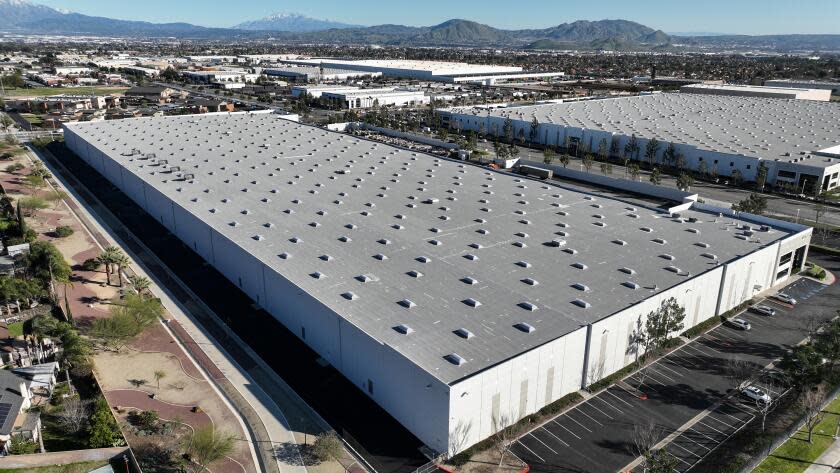Crackdown on warehouse pollution results in more than 100 violation notices

Southern California air regulators have issued more than 100 violation notices — and could levy hefty fines — to warehouse facilities across the region, citing the companies' failure to comply with new regulations that seek to curb smog-forming pollution.
"We're at a place where we are transitioning into more traditional enforcement and taking a more aggressive, stronger approach," said Terrence Mann, head of enforcement at the South Coast Air Quality Management District. "I think our agency's perspective is, enough is enough. These warehouses have had a lot of time."
Over the last decade, large warehouses and logistics centers have sprouted up across Southern California to accommodate the boom in e-commerce and goods movement. These facilities have attracted thousands of heavy-duty trucks that release smog-forming nitrogen oxides and carcinogenic diesel exhaust.
The air district's sweeping enforcement action prioritized noncompliant warehouses located in disadvantaged communities, including the Inland Empire, where residents endure the worst smog pollution in the nation.
A number of warehouses operated by Fortune 500 companies were among the list of violators cited by the air district, including: a Boeing facility in El Segundo; a UPS facility in Sylmar; a Home Depot logistics center in Irwindale; a Target distribution center in Rialto, two Wayfair warehouses in Perris; and a Costco in Jurupa Valley.
Read more: U.S. EPA will lead efforts to extinguish mystery fire smoldering in L.A. County landfill
The new regulations, which were adopted in 2021, require that thousands of warehouses offset pollution from the truck traffic they generate with clean air projects, such as the installation of electric vehicle chargers or rooftop solar panels. Warehouse operators can also choose to pay a fee that would go toward the air district's clean air initiatives.
Although the rule went into effect for the region's largest warehouses in March, only about half of the 1,019 affected facilities submitted reports detailing the actions they intended to take. Violators could face potential penalties of up to $11,700 a day for their failure to comply.
This week, the air district cited 109 warehouse operators across its four-county jurisdiction, marking one of the agency's largest crackdowns in recent memory. Agency officials said this was only the "first wave" of enforcement actions, and that they will continue issuing violations to the remaining 400 noncompliant facilities.
"What I want to make clear — for both the communities and the companies — is we're not going to stop until we see 100% compliance," Mann said.
Some of the cited companies may have either met or exceeded the air district's requirements, but failed to submit the proper reports. Two Space X facilities in Hawthorne were issued violation notices, including one with a massive X-shaped solar panel installation on its roof.
Read more: Why some people think California's cow manure methane plan stinks
Roughly 500 warehouses complied with the rule and have been found to exceed expectations, according to the air district.
"Many facilities are really starting to put in these high-power chargers that are needed for zero-emission cargo at these facilities," said Ian MacMillan, assistant deputy executive officer. "We're seeing zero-emission cargo-handling equipment, and they're finding that that technology works for them."
Next month is the deadline for the region's roughly 1,000 medium-sized warehouses to comply, marking the second phase of the program. The final phase, which includes all warehouses over 100,000 square feet, will occur in January 2025.
Once the rule is fully implemented, it is expected to reduce smog-forming emissions from warehouse operations by 10% to 15%. So far, the program has raised about $9 million in fees and reduced smog-forming nitrogen oxides by 3%, according to air district officials.
This story originally appeared in Los Angeles Times.

